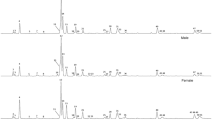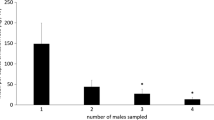Abstract
To survive unfavorable periods, ladybird beetles form conspicuous aggregations in specific microsites, with these locations remaining the same year after year. This constancy of location leads to the hypothesis that semiochemicals are involved in the attraction and aggregation of ladybirds to the microsite. In this study, we identified two types of semiochemicals that could play key roles in the attraction and aggregation formation of the two-spotted ladybird, Adalia bipunctata. We first isolated and identified three alkylmethoxypyrazines from A. bipunctata and tested the behavioral responses of diapausing ladybirds to these chemicals in a four-way olfactometer. This revealed that 2-isobutyl-3-methoxypyrazine, on its own or as part of a two-component mixture with 2-isopropyl-3-methoxypyrazine, elicited a positive behavioral response, causing arrestment of diapausing A. bipunctata. As ladybirds are in contact with each other in aggregations, we investigated the role of cuticular hydrocarbons (CHCs) in driving the cohesion and maintenance of aggregation. When an extract of CHCs from diapausing ladybirds was deposited near an alkylmethoxypyrazine source, ladybirds spent more time in the vicinity of the source. We identified a set of CHCs specific to diapausing A. bipunctata. Alkylmethoxyyrazines and CHCs thus deliver information to diapausing ladybirds searching for an aggregation site, as well as mediating several other behaviors throughout the ladybird’s life cycle. Chemical parsimony is discussed.






Similar content being viewed by others
References
Al Abassi, S., Birkett, M. A., Pettersson, J., Pickett, J. A., and Woodcock, C. M. 1998. Ladybird beetle odour identified and found to be responsible for attraction between adults. Cell. Mol. Life Sci. 54:876–879.
Bartle, K. D. 1993. Introduction to the theory of chromatographic separations with reference to gas chromatography, pp. 1–13, in P. J. Baugh (ed.), Gas chromatography. A practical approach. Oxford University Press Inc, New York.
Blomquist, G. and Bagnières, A. 2010. Insect Hydrocarbons: Biology, Biochemistry, and Chemical Ecology. Cambridge Press University.
Blum, M. S. 1996. Semiochemical parsimony in the Arthropoda. Annu. Rev. Entomol. 41:353–371.
Brower, L. P. 1996. Monarch butterfly orientation: missing pieces of a magnificent puzzle. J. Exp. Biol. 199:93–103.
Brower, L. P., Williams, E. H., Fink, L. S., Zubieta, R. R., and Ramírez, M. I. 2008. Monarch butterfly clusters provide microclimatic advantages during the overwintering season in Mexico. J. Lep. Soc. 62:177–189.
Depickère, S., Fresneau, D., Detrain, C., and Deneubourg, J.-L. 2004. Marking as a decision factor in the choice of a new resting site in Lasius niger. Insect. Soc. 51:243–246.
Development Core Team, R. 2008. R: A package for statistical computing. R Foundation for Statistical Computing, Vienna (Austria).
Durieux, D., Fischer, C., Brostaux, Y., Sloggett, J. J., Deneubourg, J.-L., Vandereycken, A., Joie, E., Wathelet, J.-P., Lognay, G., Haubruge, E., and And Verheggen, F. J. 2012. Role of long-chain hydrocarbons in the aggregative behaviour of Harmonia axyridis (Coleoptera: Coccinellidae). J. Ins. Physiol. 58:801–807.
Ferveur, J.-F., Savarit, F., O’kane, C. J., Sureau, G., Greenspan, R. J., and Jallon, J.-M. 1997. Genetic feminization of pheromones and its behavioral consequences in Drosophila males. Science 276:1555–1558.
Geiselhardt, S., Otte, T., and Hilker, M. 2009. The role of cuticular hydrocarbons in male mating behaviour of the mustard leaf beetle, Phaedon cochleariae (F.). J. Chem. Ecol. 35:1162–1171.
Goulson, D., Stout, J. C., Langley, J., and Hughes, W. O. H. 2000. Identity and function of scent marks deposited by foraging bumblebees. J. Chem. Ecol. 26:2897–2911.
Hemptinne, J.-L. 1985. Dormancy sites of the ladybird Adalia bipunctata (L.) (Coleoptera: Coccinellidae) in Belgium. Acta Oecol.-Oec Appl. 6:3–13.
Hemptinne, J.-L. and Dixon, A. F. G. 2000. Defence, oviposition and sex: Semiochemical parsimony in two species of ladybird beetles (Coleoptera, Coccinellidae)? A short review. Eur. J. Entomol. 97:443–447.
Hemptinne, J.-L., Lognay, G., and Dixon, A. F. G. 1998. Mate recognition in the two-spot ladybird beetle, Adalia bipunctata: role of chemical and behavioural cues. J. Insect Physiol. 44:1163–1171.
Hodek, I. and Honek, A. 1996. Ecology of Coccinellidae. Kluwer Academic Publisher, Dordrecht, 464 pages.
Liebig, J., Peeters, C., Oldham, N. J., Markstädter, C., and Hölldobler, B. 2000. Are variations in cuticular hydrocarbons of queens and workers a reliable signal of fertility in the ant Harpegnathos saltator? Proc. Natl. Acad. Sci. USA 97:4124–4131.
Lockey, K. H. 1988. Lipids of the insect cuticle: Origin, composition and function. Comp. Biochem. Physiol. B. Comp. Biochem. 89:595–645.
Magro, A., Lecompte, E., Magné, F., Hemptinne, J.-L., and Crouau-Roy, B. 2010. Phylogeny of ladybirds (Coleoptera: Coccinelldiae): Are the subfamilies monophyletic? Mol. Phylo. Evol. 54:833–848.
Majerus, M. E. N. 1994. Ladybirds. Harper Collins publishers, Somerset.
Majerus, M. E. N. 1997. How is Adalia bipunctata (Linn.) (Coleoptera: Coccinellidae) attracted to overwintering sites? The Entomologist 116:212–217.
Mcclure, M. and Despland, E. 2011. Defensive responses by a social caterpillar are tailored to different predators and change with larval instar and group size. Naturwissenschaften 98:425–434.
Moore, B. P., Brown, W. V., and Rothschild, M. 1990. Methylalkylpyrazines in aposematic insects, their hostplants and mimics. Chemoecology 1:43–51.
Mooring, M. S. and Hartl, B. L. 1992. Animal grouping for protection for parasites—selfish herd and encounter-dilution effects. Behaviour 123:173–193.
Nalepa, C. A. and Weir, A. 2007. Infection of Harmonia axyridis (Coleoptera: Coccinellidae) by Hesperomyces virescens (Ascomycetes: Laboulbeniales): Role of mating status and aggregation behaviour. J. Invert. Pathol. 94:196–203.
Nalepa, C. A., Kennedy, G. G., and Brownie, C. 2005. Role of visual contrast in the alighting behaviour of Harmonia axyridis (Coleoptera: Coccinellidae) at overwintering sites. Environ. Entomol. 34:425–431.
NIST. 2005. NIST mass spectral search for the NIST/EPA/NIH mass spectral library version 2.0. Office of the Standard Reference Data Base, National Institute of Standards and Technology, Gaithersburg, Maryland.
Obrycki, J. J., Tauber, M. J., Tauber, C. A., and Gollands, B. 1983. Environmental control of the seasonal life cycle of Adalia bipunctata (Coleoptera: Coccinellidae). Environ. Entomol. 12:416–421.
Omkar and Pervez, A. 2005. Ecology of two-spotted ladybird, Adalia bipunctata: A review. J. Appl. Entomol. 129:465–474.
Peterson, M. A., Dobler, S., Larson, E. L., Juárez, D., Schlarbaum, T., Monsen, K. J., and Francke, W. 2007. Profiles of cuticular hydrocarbons mediate male mate choice and sexual isolation between hybridising Chrysochus (Coleoptera: Chrysomelidae). Chemoecology 17:87–96.
Pickett, J. A. 1990. Gas chromatography—mass spectrometry in insect pheromone identification: Three extreme cases, pp. 209–309, in A. R. McCaffery and I. D. Wilson (eds.), Chromatography and isolation of insect pheromones and hormones. Plenum Press, New York.
Rankin, S. M. and Rankin, M. A. 1980. The hormonal control of migratory flight behaviour in the convergent ladybird beetle, Hippodamia convergens. Physiol. Entomol. 5:175–182.
Sabu, T. K., Vinod, K. V., and Jobi, M. C. 2008. Life history, aggregation and dormancy of the rubber plantation litter beetle, Luprops tristis, from the rubber plantation of moist south Western Ghats. J. Insect Sci. 8:1–17.
Salisbury, A., Cook, S. M., Powell, W., and Hardie, J. 2012. Odour-mediated orientation behaviour of the lily beetle Lilioceris lilii. Physiol. Entomol. 37:97–102.
Siegel, S. 1956. Non- parametric Statistics for the Behavioural Sciences. London: McGraw-Hill International Book Company, 320 pages.
Skelton, A. C., Cameron, M. M., Pickett, J. A., and Birkett, M. A. 2010. Identification of neryl formate as an airborne aggregation pheromone for the American house dust mite, Dermatophagoides farinae, and the European house dust mite, Dermatophagoides pteronyssinus (Acari: Epidermoptidae). J. Med. Entomol. 47:798–804.
Toyama, M., Ihara, F., and Yaginuma, K. 2006. Formation of aggregations in adults of the brown marmorated stink bug, Halyomorpha halys (Heteroptera: Pentatomidae): The role of antennae in short-range locations. Appl. Entomol. Zool. 41:309–315.
Verheggen, F. J., Fagel, Q., Heuskin, S., Lognay, G., Francis, F., and Haubruge, E. 2007. Electrophysiological and behavioural responses of the multicolored asian lady beetle, Harmonia axyridis Pallas, to sesquiterpene semiochemicals. J. Chem. Ecol. 33:2148–2155.
Vet, L. E. M., Van Lenteren, J. C., Heymans, M., and Meelis, E. 1983. An airflow olfactometer for measuring olfactory responses of hymenopterous parasitoids and other small insects. Physiol. Entomol. 8:97–106.
Wertheim, B., van Baalen, E.-J. A., Dicke, M., and Vet, L. E. M. 2005. Pheromone-mediated aggregation in non-social arthropods: An evolutionary ecological perspective. Annu. Rev. Entomol 50:321–346.
Wolda, H. and Denlinger, D. L. 1984. Diapause in a large aggregation of a tropical beetle. Ecol. Entomol. 9:217–230.
Acknowledgements
The authors thank Nathalie Dardenne and Jean-François Garrigues for technical assistance, Christine Ducamp for identifying chemical compounds in the bulk CHC extract, and two anonymous reviewers for their constructive suggestions. The laboratory “Evolution et Diversité Biologique” (UMR CNRS 5174) is part of the “Laboratory d’Excellence” (LABEX) entitled TULIP (ANR-10-LABX-41). Rothamsted Research receives grant-aided support from the Biotechnology and Biological Sciences Research Council (BBSRC) of the United Kingdom. JLH and MAB benefited from a France-UK collaborative grant (PHC Alliance 19422NG) and FRP from an Erasmus travel grant.
Author information
Authors and Affiliations
Corresponding author
Rights and permissions
About this article
Cite this article
Susset, E.C., Ramon-Portugal, F., Hemptinne, JL. et al. The Role of Semiochemicals in Short-Range Location of Aggregation Sites in Adalia bipunctata (Coleoptera, Coccinellidae). J Chem Ecol 39, 591–601 (2013). https://doi.org/10.1007/s10886-013-0285-0
Received:
Revised:
Accepted:
Published:
Issue Date:
DOI: https://doi.org/10.1007/s10886-013-0285-0




